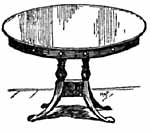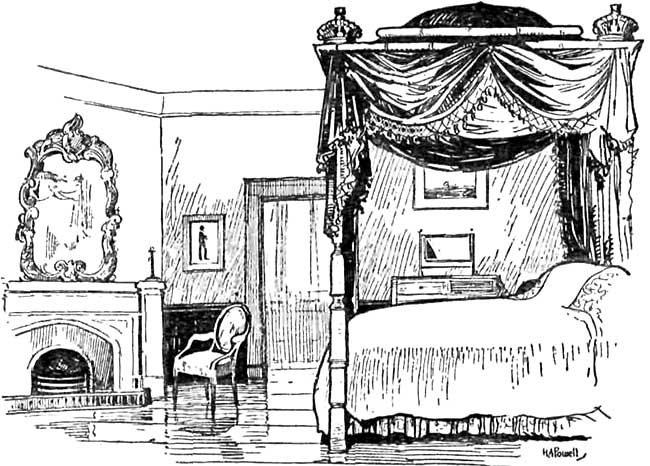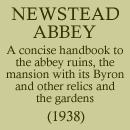
Byron's writing table.
This room—hardly wider than a passage—leads into Byron's Bedroom where his great four-poster bed, richly gilt and with coronets adorning the top of it, is the central object of interest. Here also is the famous round table on which he wrote some of his works, while other pieces of furniture which he had in daily use complete the contents of the room. The remarkable mirror over the fire-place should be noted. The third small room of the "Byron group" is one of special interest on various accounts. Its walls still show the original stonework of monastic times, neither panelled nor plastered, and the little apartment thus conveys a realistic picture of what the interior of the monastery buildings was like. The room is best known in local tradition as the "Haunted Room," but is more precisely described as the Prior's Oratory, and its chief significance seems to have been that by virtue of its position it served as a vantage point from which the Prior—whose personal apartments these were—could keep an eye on all that was happening in the Abbey Church below, for the room has a two-light Gothic window which looked down into the church. The supernatural tradition connected with it is concerned with the restless spirit of a monk, whose form is said to appear here at intervals.
 Byron's Bedroom.
Byron's Bedroom. A more lively story about this room, and one of more modern origin, is well worth recounting here, for it does not seem yet to have found a place in the numerous books and pamphlets already published about Newstead. The late King Edward VII, when Prince of Wales, visited Newstead with the Princess (afterwards Queen Alexandra). The route which the royal party were to follow in their inspection of the Abbey had been arranged beforehand, and the domestic servants of the mansion, having been informed of the plan, took up vantage points from which they could watch the royal progress through the buildings. Two of the maids stationed themselves in this room while the visit was in progress, intending to leave it before the Prince and Princess arrived. At the last moment, however, a change of route was decided upon, and the royal visitors were suddenly heard approaching this room by the only means of reaching it—that is, by the narrow spiral staircase—with the result that the agitated servants found their retreat cut off. The only way of "making themselves scarce" was to hide behind a curtain which screened a deep recess in one of the walls, and this they did. A moment later the royal party entered. "This is the Haunted Room" they were informed. "Ah, yes!" exclaimed the Princess of Wales," and I suppose the ghost hides behind that curtain?" whereupon she gave the curtain a vigorous prod with her umbrella. A hideous scream from the screened recess startled the company into the momentary belief that the ghost was actually "on duty," but when the curtain was gingerly drawn aside it revealed only the two domestics, one of whom had evidently been caught in a sensitive spot by the tip of the Princess's umbrella!
Now we must return down the little winding stair, and passing through a door at this end of the Corridor we find ourselves at the head of a broader stone staircase similar in character to that by which we climbed to the Dining-Hall at the commencement of our tour. On this staircase hangs a full-length portrait of General Goodlake, V.C., of Crimean fame, in his red tunic. Reaching the foot of the staircase we enter the Cloisters, which form the most extensive individual feature of the original Abbey now surviving, and which deserve detailed description and study.
The complete quadrangle of the Cloister is open to our inspection and it is well to follow the ancient custom of the monks when taking exercise in bad weather—that is to say, to walk slowly round the four sides of the cloister so as to study its details one by one and to gain the varied pictures of the Abbey buildings afforded by its traceried windows. The northern walk of the Cloister runs parallel with the Abbey church and occupies what would in most cases have been the site of the south aisle of the church. But it was a peculiarity of the buildings of the particular Order identified with Newstead that their churches were built without south aisles, and in this respect Newstead agrees with the plan of Shap Abbey in Westmorland which belonged to the same Order.
In the wall at the north-east angle of the cloister may be seen remains of columns indicating a doorway which led into the church; this doorway was for the use of the novices, servants and others who were not entitled to sit east of the choir screen. We cannot proceed far with our perambulation of the Cloister without stopping to admire the remarkable Fountain which stands in the centre of the Cloister garth. This, of course, is its true position, although as we have seen from Tilleman's painting in the Great Drawing-Room, it was removed after the Reformation and for a considerable period stood in the open space to the west of the Abbey buildings. The design of this fountain, with its curious "beasties" carved in stone, is unique in England. The base has been restored (probably about the time of Charles II) and is possibly very different from the original, but the upper portions are ancient. It was Colonel Wildman who moved it back to its original site. Our illustration shows not only the charming design of the fountain itself but also records the interesting peep of the top of the west front of the Abbey church which we gain from the Cloister.
The northern walk of the Cloister leads straight up to the entrance to what was until recent times a billiards room, occupying the site of the south transept of the church. It has a fine ceiling, the design of which is attributed to Inigo Jones, one of the most famous architects of the Renaissance. The furniture, pictures, etc., in this room are the property of Mr. C. I. Fraser, and are on loan to the Corporation of Nottingham. The pictures represent many members of the Webb family. There is also in this room a large collection of relics collected in the Crimea by General Goodlake, V.C., during the Crimean War.
